check engine Peugeot 207 CC 2014 User Guide
[x] Cancel search | Manufacturer: PEUGEOT, Model Year: 2014, Model line: 207 CC, Model: Peugeot 207 CC 2014Pages: 232, PDF Size: 11.11 MB
Page 79 of 232
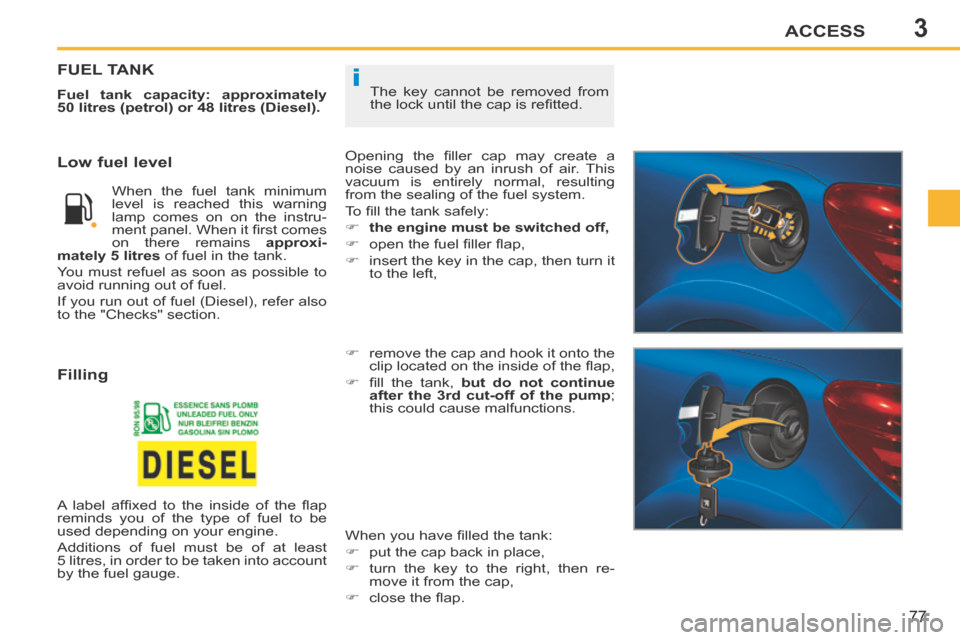
3
i
ACCESS
77
207CC_EN_CHAP03_OUVERTURES_ED01-2014
The key cannot be removed from
the lock until the cap is refi tted.
FUEL TANK
Fuel tank capacity: approximately
50 litres (petrol) or 48 litres (Diesel). Opening the fi ller cap may create a
noise caused by an inrush of air. This
vacuum is entirely normal, resulting
from the sealing of the fuel system.
To fi ll the tank safely:
the engine must be switched off,
open the fuel fi ller fl ap,
insert the key in the cap, then turn it to the left,
When you have fi lled the tank:
put the cap back in place,
turn the key to the right, then re- move it from the cap,
close the fl ap. remove the cap and hook it onto the clip located on the inside of the fl ap,
fi ll the tank, but do not continue
after the 3rd cut-off of the pump ;
this could cause malfunctions.
Low fuel level
When the fuel tank minimum
level is reached this warning
lamp comes on on the instru-
ment panel. When it fi rst comes
on there remains approxi-
mately 5 litres of fuel in the tank.
You must refuel as soon as possible to
avoid running out of fuel.
If you run out of fuel (Diesel), refer also
to the "Checks" section.
Filling
A label affi xed to the inside of the fl ap
reminds you of the type of fuel to be
used depending on your engine.
Additions of fuel must be of at least
5 litres, in order to be taken into account
by the fuel gauge.
Page 81 of 232
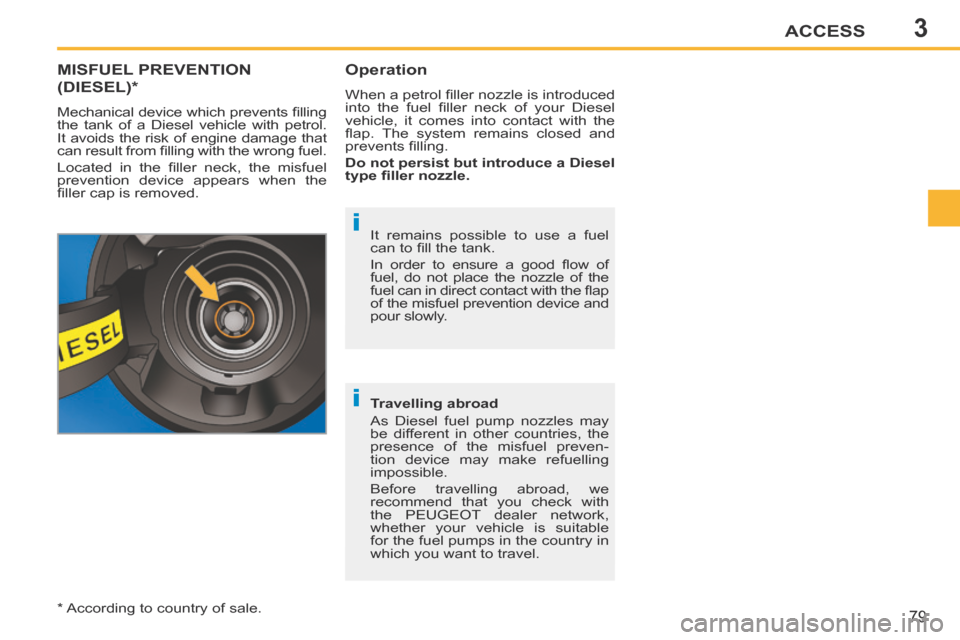
3
i
i
ACCESS
79
207CC_EN_CHAP03_OUVERTURES_ED01-2014
MISFUEL PREVENTION
(DIESEL) *
Mechanical device which prevents fi lling
the tank of a Diesel vehicle with petrol.
It avoids the risk of engine damage that
can result from fi lling with the wrong fuel.
Located in the fi ller neck, the misfuel
prevention device appears when the
fi ller cap is removed.
Operation
When a petrol fi ller nozzle is introduced
into the fuel fi ller neck of your Diesel
vehicle, it comes into contact with the
fl ap. The system remains closed and
prevents fi lling.
Do not persist but introduce a Diesel
type fi ller nozzle. It remains possible to use a fuel
can to fi ll the tank.
In order to ensure a good fl ow of
fuel, do not place the nozzle of the
fuel can in direct contact with the fl ap
of the misfuel prevention device and
pour slowly.
* According to country of sale. Travelling abroad
As Diesel fuel pump nozzles may
be different in other countries, the
presence of the misfuel preven-
tion device may make refuelling
impossible.
Before travelling abroad, we
recommend that you check with
the PEUGEOT dealer network,
whether your vehicle is suitable
for the fuel pumps in the country in
which you want to travel.
Page 103 of 232
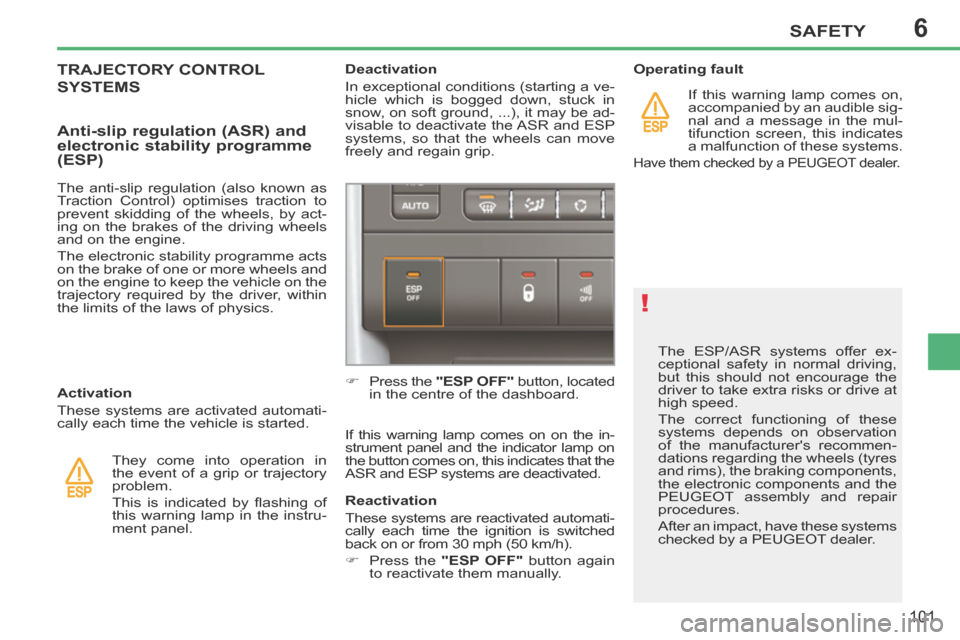
6
!
SAFETY
101
207CC_EN_CHAP06_SECURITE_ED01-2014
The ESP/ASR systems offer ex-
ceptional safety in normal driving,
but this should not encourage the
driver to take extra risks or drive at
high speed.
The correct functioning of these
systems depends on observation
of the manufacturer's recommen-
dations regarding the wheels (tyres
and rims), the braking components,
the electronic components and the
PEUGEOT assembly and repair
procedures.
After an impact, have these systems
checked by a PEUGEOT dealer.
Deactivation
In exceptional conditions (starting a ve-
hicle which is bogged down, stuck in
snow, on soft ground, ...), it may be ad-
visable to deactivate the ASR and ESP
systems, so that the wheels can move
freely and regain grip.
Press the "ESP OFF" button, located
in the centre of the dashboard.
If this warning lamp comes on on the in-
strument panel and the indicator lamp on
the button comes on, this indicates that the
ASR and ESP systems are deactivated.
Reactivation
These systems are reactivated automati-
cally each time the ignition is switched
back on or from 30 mph (50 km/h).
Press the "ESP OFF" button again
to reactivate them manually. Operating fault
If this warning lamp comes on,
accompanied by an audible sig-
nal and a message in the mul-
tifunction screen, this indicates
a malfunction of these systems.
Have them checked by a PEUGEOT dealer.
TRAJECTORY CONTROL
SYSTEMS
Activation
These systems are activated automati-
cally each time the vehicle is started.
Anti-slip regulation (ASR) and
electronic stability programme
(ESP)
They come into operation in
the event of a grip or trajectory
problem.
This is indicated by fl ashing of
this warning lamp in the instru-
ment panel.
The anti-slip regulation (also known as
Traction Control) optimises traction to
prevent skidding of the wheels, by act-
ing on the brakes of the driving wheels
and on the engine.
The electronic stability programme acts
on the brake of one or more wheels and
on the engine to keep the vehicle on the
trajectory required by the driver, within
the limits of the laws of physics.
Page 122 of 232
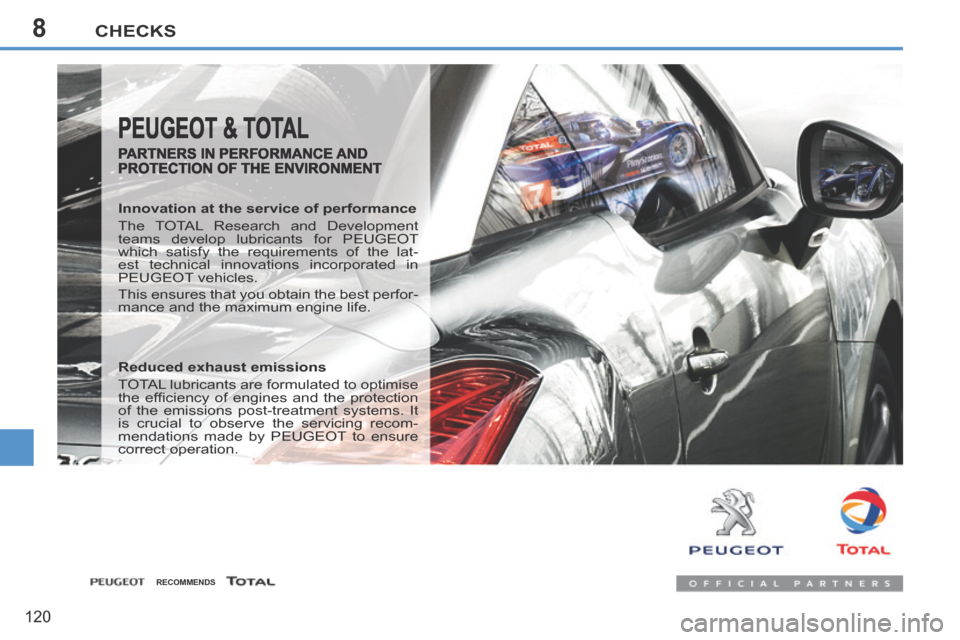
8CHECKS
120
207CC_EN_CHAP08_VERIFICATIONS_ED01-2014
PEUGEOT & TOTAL
PARTNERS IN PERFORMANCE AND PROTECTION OF THE ENVIRONMENT
Innovation at the service of performance
The TOTAL Research and Development
teams develop lubricants for PEUGEOT
which satisfy the requirements of the lat-
est technical innovations incorporated in
PEUGEOT vehicles.
This ensures that you obtain the best perfor-
mance and the maximum engine life.
Reduced exhaust emissions
TOTAL lubricants are formulated to optimise
the effi ciency of engines and the protection
of the emissions post-treatment systems. It
is crucial to observe the servicing recom-
mendations made by PEUGEOT to ensure
correct operation.
RECOMMENDS
Page 123 of 232

8
i
!
CHECKS
121
207CC_EN_CHAP08_VERIFICATIONS_ED01-2014
BONNET
Protects the components of the engine
and provides access for checking levels.
Push the exterior safety catch B to
the left and raise the bonnet. Unclip the stay
C from its housing.
Fix the stay in one of the two notch- es to hold the bonnet open.
Closing
Take the stay out of the support notch.
Clip the stay in its housing.
Lower the bonnet and release it at the end of its travel.
Pull on the bonnet to check that it is secured correctly.
RUNNING OUT OF FUEL
(DIESEL)
Opening
Open the front left door.
Pull the interior release lever A ,
located at the bottom of the door
frame.
The location of the interior release
lever prevents opening of the bon-
net while the left hand front door is
closed.
When the engine is hot, handle the
exterior safety catch and bonnet
stay with care (risk of burns).
1.6 litre HDi engine
Fill the fuel tank with at least fi ve li-tres of diesel.
Open the bonnet.
If necessary, unclip the styling cover for access to the priming pump.
Squeeze and release the priming pump repeatedly until resistance is
felt (there may be resistance at the
fi rst press).
Operate the starter until the engine
starts (if the engine does not start at the
fi rst attempt, wait around 15 seconds
before trying again).
If the engine does not start after a few attempts, operate the priming
pump again then start the engine.
Clip the styling cover back in place.
Close the bonnet. On vehicles fi tted with HDi engines, the
fuel system must be primed if you run
out of fuel; refer to the corresponding
engine compartment view.
If the tank on your vehicle is fi tted with
a misfuel prevention device, refer to the
"Misfuel prevention (Diesel)" section.
Because of the presence of elec-
trical equipment under the bonnet,
it is recommended that exposure
to water (rain, washing, ...) be re-
stricted. If the engine does not start fi rst time,
don't keep trying but start the procedure
again from the beginning.
Page 124 of 232
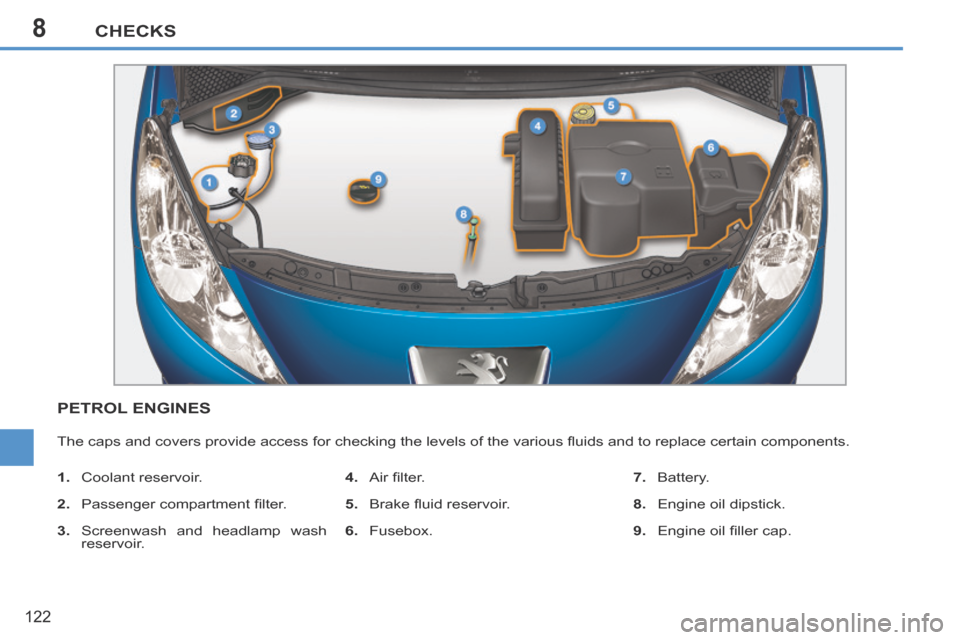
8CHECKS
122
207CC_EN_CHAP08_VERIFICATIONS_ED01-2014
PETROL ENGINES
The caps and covers provide access for checking the levels of the various fl uids and to replace certain components.
1. Coolant reservoir.
2. Passenger compartment fi lter.
3. Screenwash and headlamp wash reservoir. 4. Air fi lter.
5. Brake fl uid reservoir.
6. Fusebox.
7. Battery.
8. Engine oil dipstick.
9. Engine oil fi ller cap.
Page 125 of 232
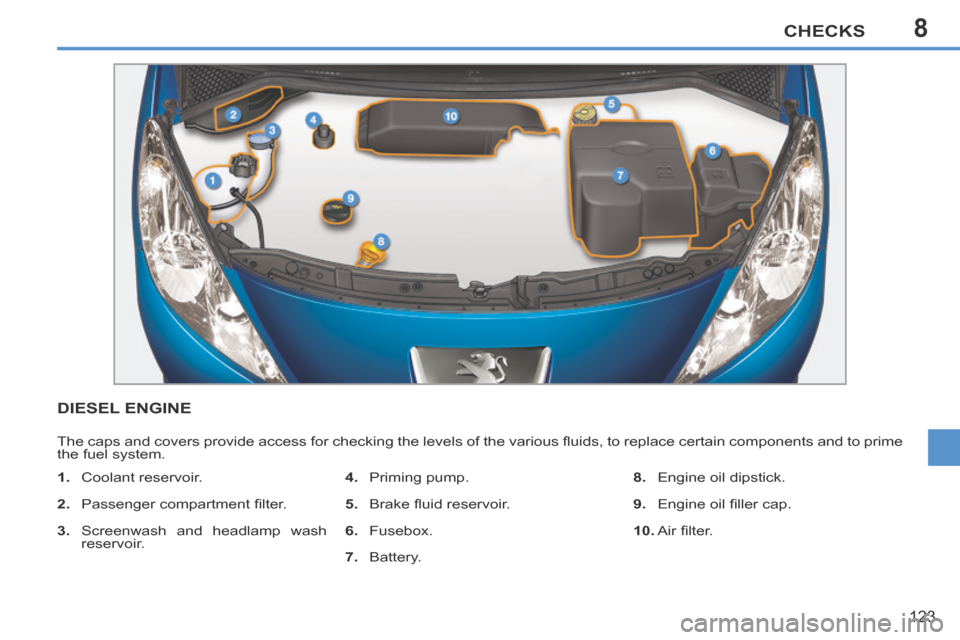
8CHECKS
123
207CC_EN_CHAP08_VERIFICATIONS_ED01-2014
DIESEL ENGINE
The caps and covers provide access for checking the levels of the various fl uids, to replace certain components and to prime
the fuel system.
1. Coolant reservoir.
2. Passenger compartment fi lter.
3. Screenwash and headlamp wash reservoir. 4. Priming pump.
5. Brake fl uid reservoir.
6. Fusebox.
7. Battery. 8. Engine oil dipstick.
9. Engine oil fi ller cap.
10. Air fi lter.
Page 126 of 232
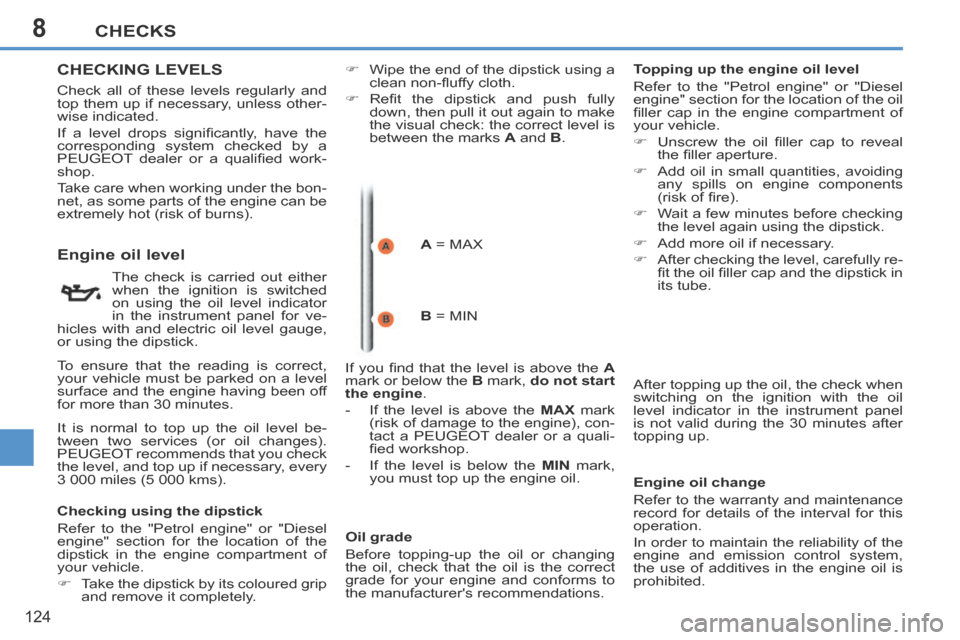
8CHECKS
124
207CC_EN_CHAP08_VERIFICATIONS_ED01-2014
CHECKING LEVELS
Check all of these levels regularly and
top them up if necessary, unless other-
wise indicated.
If a level drops signifi cantly, have the
corresponding system checked by a
PEUGEOT dealer or a qualifi ed work-
shop.
Take care when working under the bon-
net, as some parts of the engine can be
extremely hot (risk of burns).
Engine oil level
The check is carried out either
when the ignition is switched
on using the oil level indicator
in the instrument panel for ve-
hicles with and electric oil level gauge,
or using the dipstick.
To ensure that the reading is correct,
your vehicle must be parked on a level
surface and the engine having been off
for more than 30 minutes.
It is normal to top up the oil level be-
tween two services (or oil changes).
PEUGEOT recommends that you check
the level, and top up if necessary, every
3 000 miles (5 000 kms).
Checking using the dipstick
Refer to the "Petrol engine" or "Diesel
engine" section for the location of the
dipstick in the engine compartment of
your vehicle.
Take the dipstick by its coloured grip and remove it completely. A = MAX
B = MIN
If you fi nd that the level is above the A
mark or below the B mark, do not start
the engine .
- If the level is above the MAX mark
(risk of damage to the engine), con-
tact a PEUGEOT dealer or a quali-
fi ed workshop.
- If the level is below the MIN mark,
you must top up the engine oil.
Oil grade
Before topping-up the oil or changing
the oil, check that the oil is the correct
grade for your engine and conforms to
the manufacturer's recommendations. Topping up the engine oil level
Refer to the "Petrol engine" or "Diesel
engine" section for the location of the oil
fi ller cap in the engine compartment of
your vehicle.
Unscrew the oil fi ller cap to reveal
the fi ller aperture.
Add oil in small quantities, avoiding any spills on engine components
(risk of fi re).
Wait a few minutes before checking the level again using the dipstick.
Add more oil if necessary.
After checking the level, carefully re- fi t the oil fi ller cap and the dipstick in
its tube.
After topping up the oil, the check when
switching on the ignition with the oil
level indicator in the instrument panel
is not valid during the 30 minutes after
topping up.
Engine oil change
Refer to the warranty and maintenance
record for details of the interval for this
operation.
In order to maintain the reliability of the
engine and emission control system,
the use of additives in the engine oil is
prohibited.
Wipe the end of the dipstick using a
clean non-fl uffy cloth.
Refi t the dipstick and push fully down, then pull it out again to make
the visual check: the correct level is
between the marks A and B .
Page 127 of 232
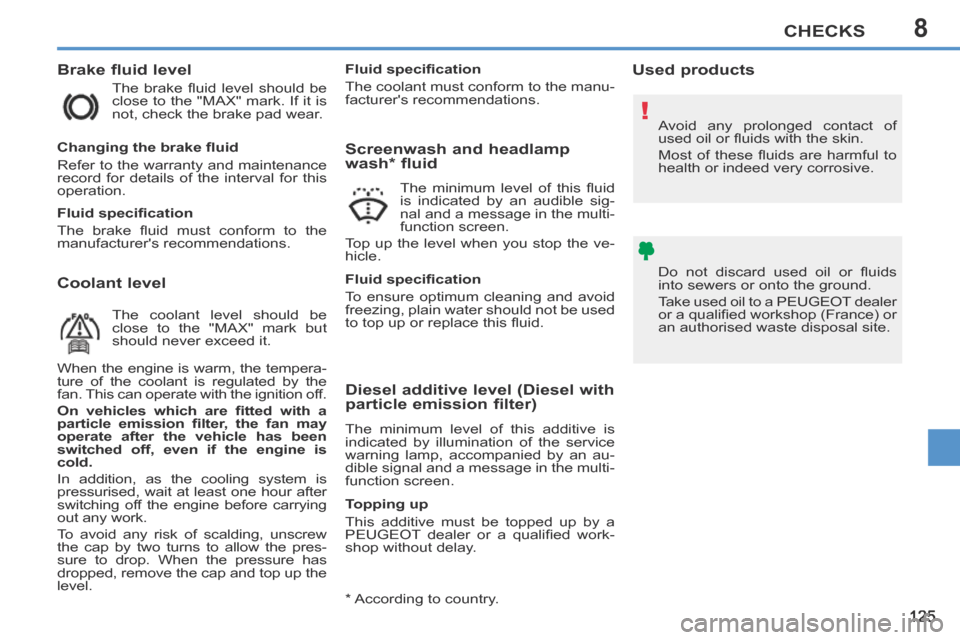
8
!
CHECKS
125
207CC_EN_CHAP08_VERIFICATIONS_ED01-2014
Coolant level Brake fluid level
The brake fl uid level should be
close to the "MAX" mark. If it is
not, check the brake pad wear.
The coolant level should be
close to the "MAX" mark but
should never exceed it.
When the engine is warm, the tempera-
ture of the coolant is regulated by the
fan. This can operate with the ignition off.
On vehicles which are fi tted with a
particle emission fi lter, the fan may
operate after the vehicle has been
switched off, even if the engine is
cold.
In addition, as the cooling system is
pressurised, wait at least one hour after
switching off the engine before carrying
out any work.
To avoid any risk of scalding, unscrew
the cap by two turns to allow the pres-
sure to drop. When the pressure has
dropped, remove the cap and top up the
level.
Screenwash and headlamp
wash * fluid
The minimum level of this fl uid
is indicated by an audible sig-
nal and a message in the multi-
function screen.
Top up the level when you stop the ve-
hicle.
* According to country.
Fluid specifi cation
The brake fl uid must conform to the
manufacturer's recommendations.
Fluid specifi cation
The coolant must conform to the manu-
facturer's recommendations.
Fluid specifi cation
To ensure optimum cleaning and avoid
freezing, plain water should not be used
to top up or replace this fl uid.
Changing the brake fl uid
Refer to the warranty and maintenance
record for details of the interval for this
operation.
Avoid any prolonged contact of
used oil or fl uids with the skin.
Most of these fl uids are harmful to
health or indeed very corrosive.
Do not discard used oil or fl uids
into sewers or onto the ground.
Take used oil to a PEUGEOT dealer
or a qualifi ed workshop (France) or
an authorised waste disposal site.
Diesel additive level (Diesel with
particle emission filter)
The minimum level of this additive is
indicated by illumination of the service
warning lamp, accompanied by an au-
dible signal and a message in the multi-
function screen.
Used products
Topping up
This additive must be topped up by a
PEUGEOT dealer or a qualifi ed work-
shop without delay.
Page 128 of 232
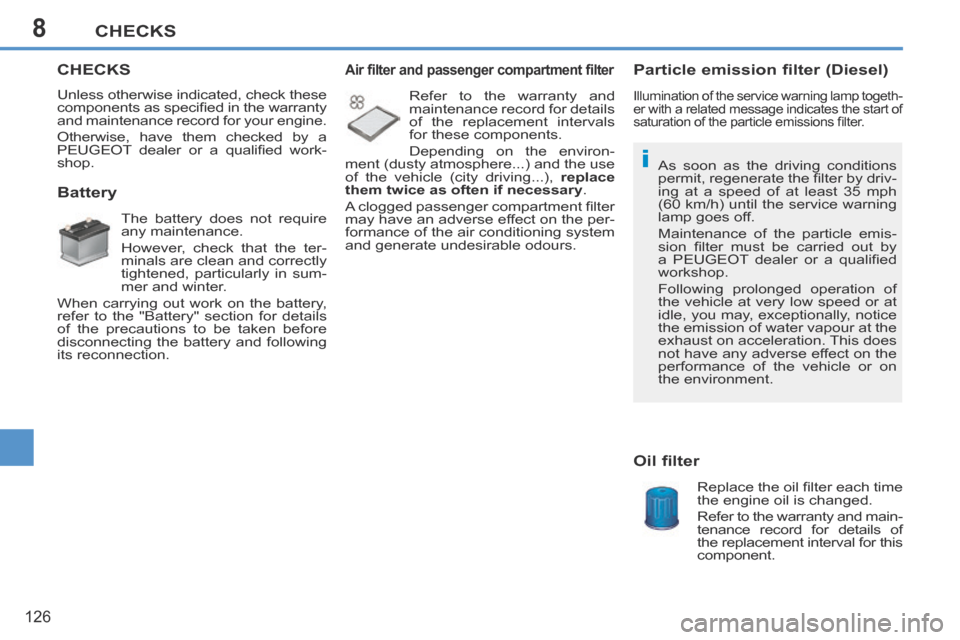
8
i
CHECKS
126
207CC_EN_CHAP08_VERIFICATIONS_ED01-2014
CHECKS
Unless otherwise indicated, check these
components as specifi ed in the warranty
and maintenance record for your engine.
Otherwise, have them checked by a
PEUGEOT dealer or a qualifi ed work-
shop.
Battery
The battery does not require
any maintenance.
However, check that the ter-
minals are clean and correctly
tightened, particularly in sum-
mer and winter.
When carrying out work on the battery,
refer to the "Battery" section for details
of the precautions to be taken before
disconnecting the battery and following
its reconnection.
Air filter and passenger compartment filter
Refer to the warranty and
maintenance record for details
of the replacement intervals
for these components.
Depending on the environ-
ment (dusty atmosphere...) and the use
of the vehicle (city driving...), replace
them twice as often if necessary .
A clogged passenger compartment fi lter
may have an adverse effect on the per-
formance of the air conditioning system
and generate undesirable odours.
Particle emission filter (Diesel)
Illumination of the service warning lamp togeth-
er with a related message indicates the start of
saturation of the particle emissions fi lter.
Oil filter
Replace the oil fi lter each time
the engine oil is changed.
Refer to the warranty and main-
tenance record for details of
the replacement interval for this
component.
As soon as the driving conditions
permit, regenerate the fi lter by driv-
ing at a speed of at least 35 mph
(60 km/h) until the service warning
lamp goes off.
Maintenance of the particle emis-
sion fi lter must be carried out by
a PEUGEOT dealer or a qualifi ed
workshop.
Following prolonged operation of
the vehicle at very low speed or at
idle, you may, exceptionally, notice
the emission of water vapour at the
exhaust on acceleration. This does
not have any adverse effect on the
performance of the vehicle or on
the environment.